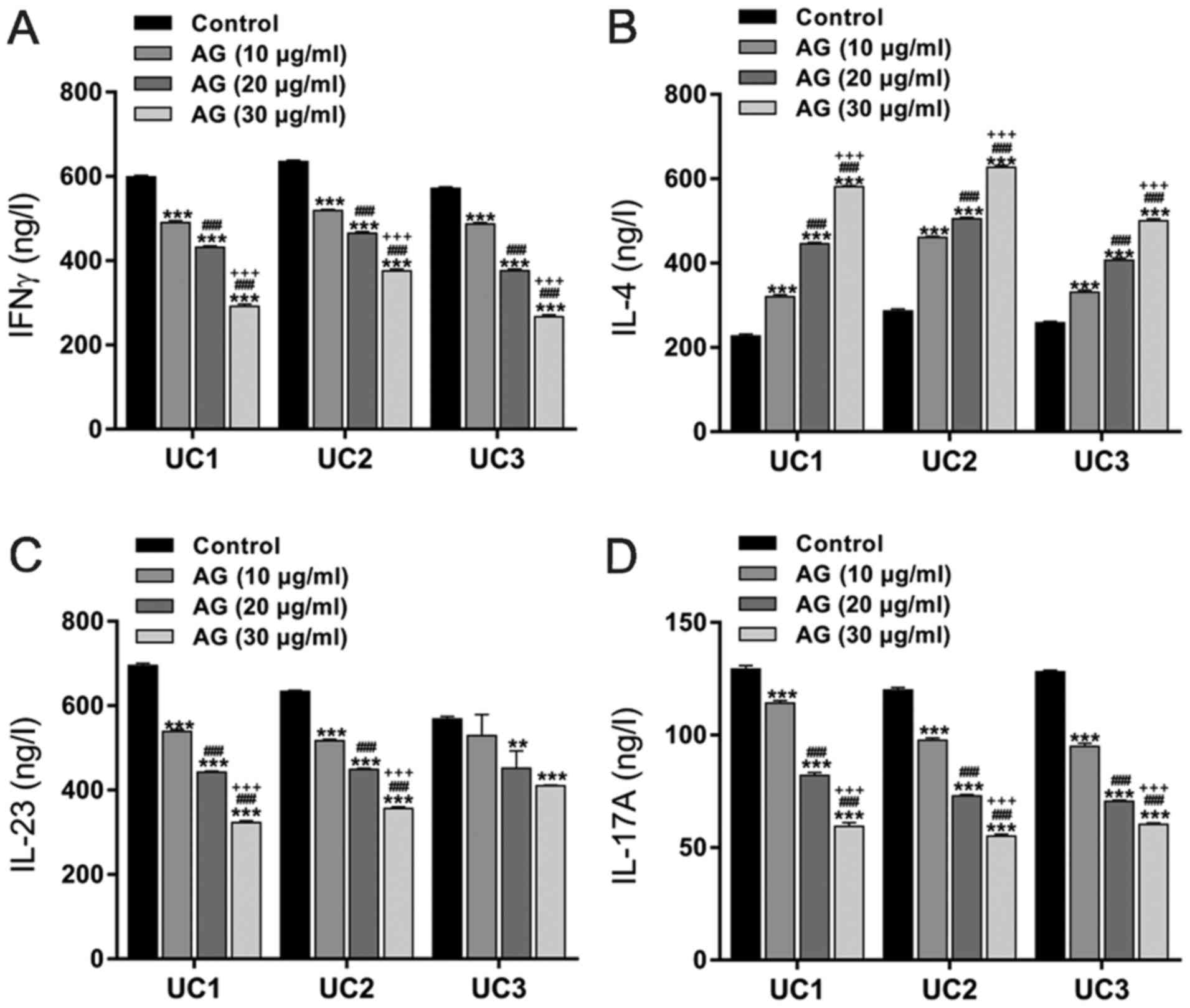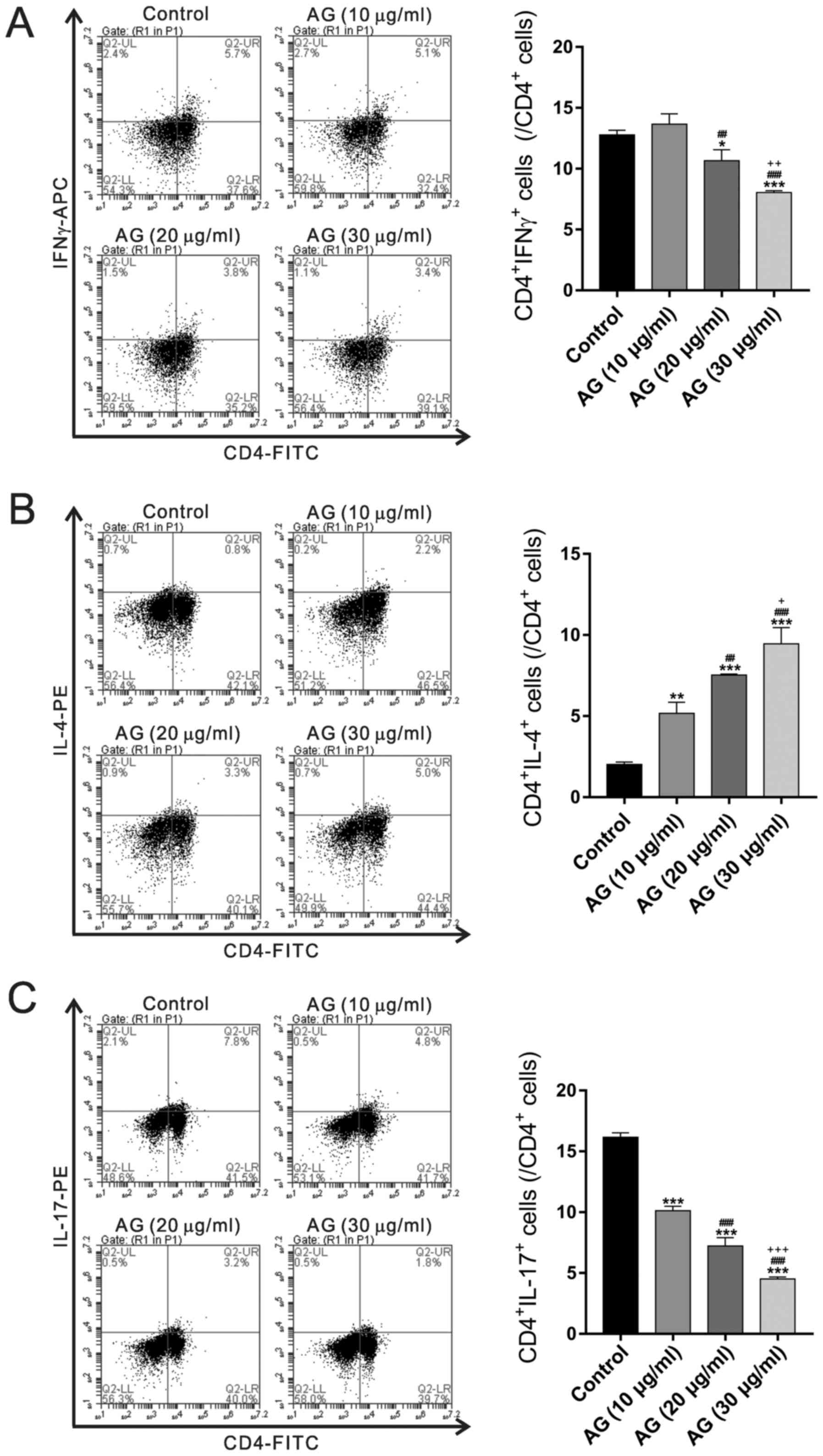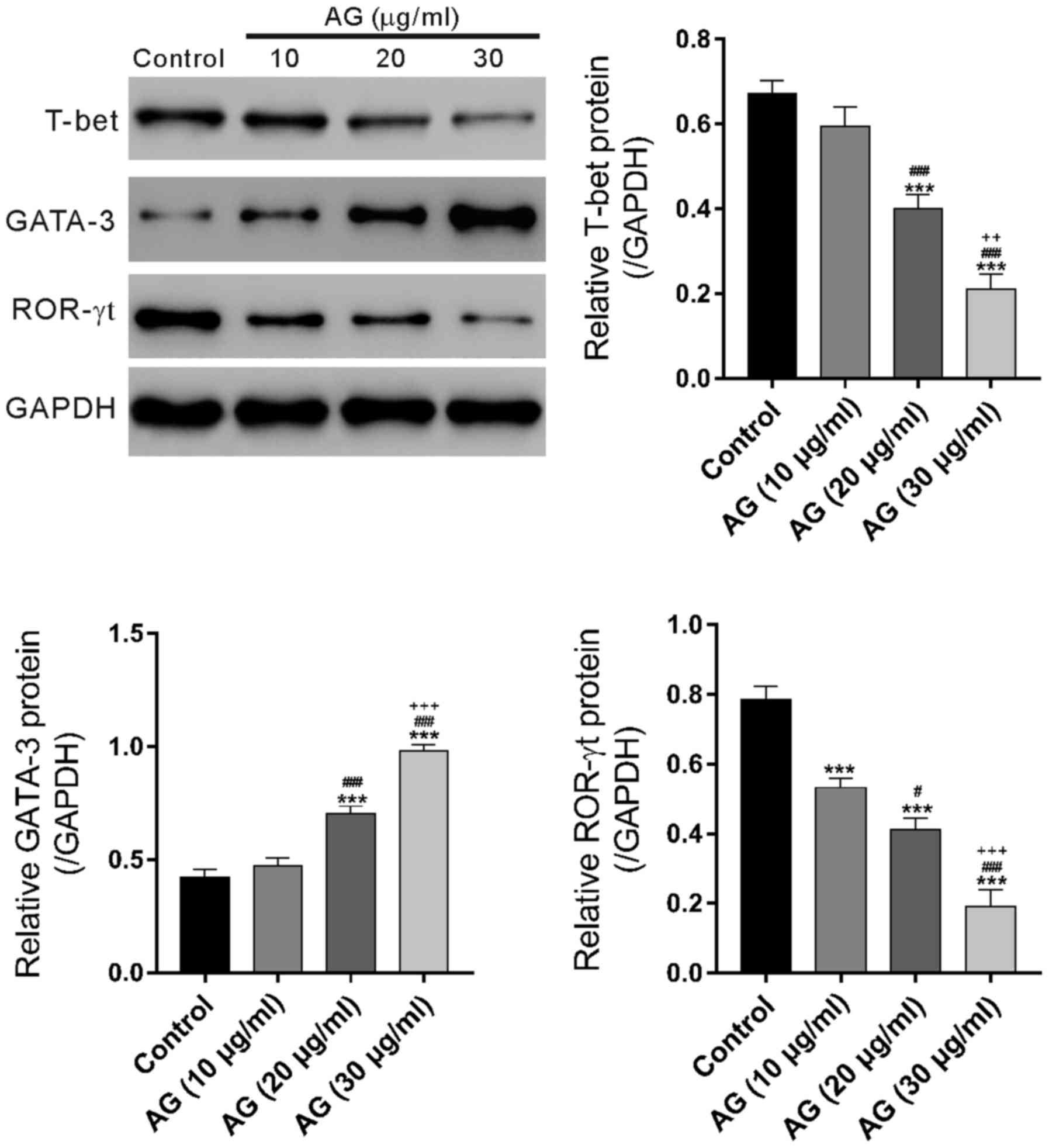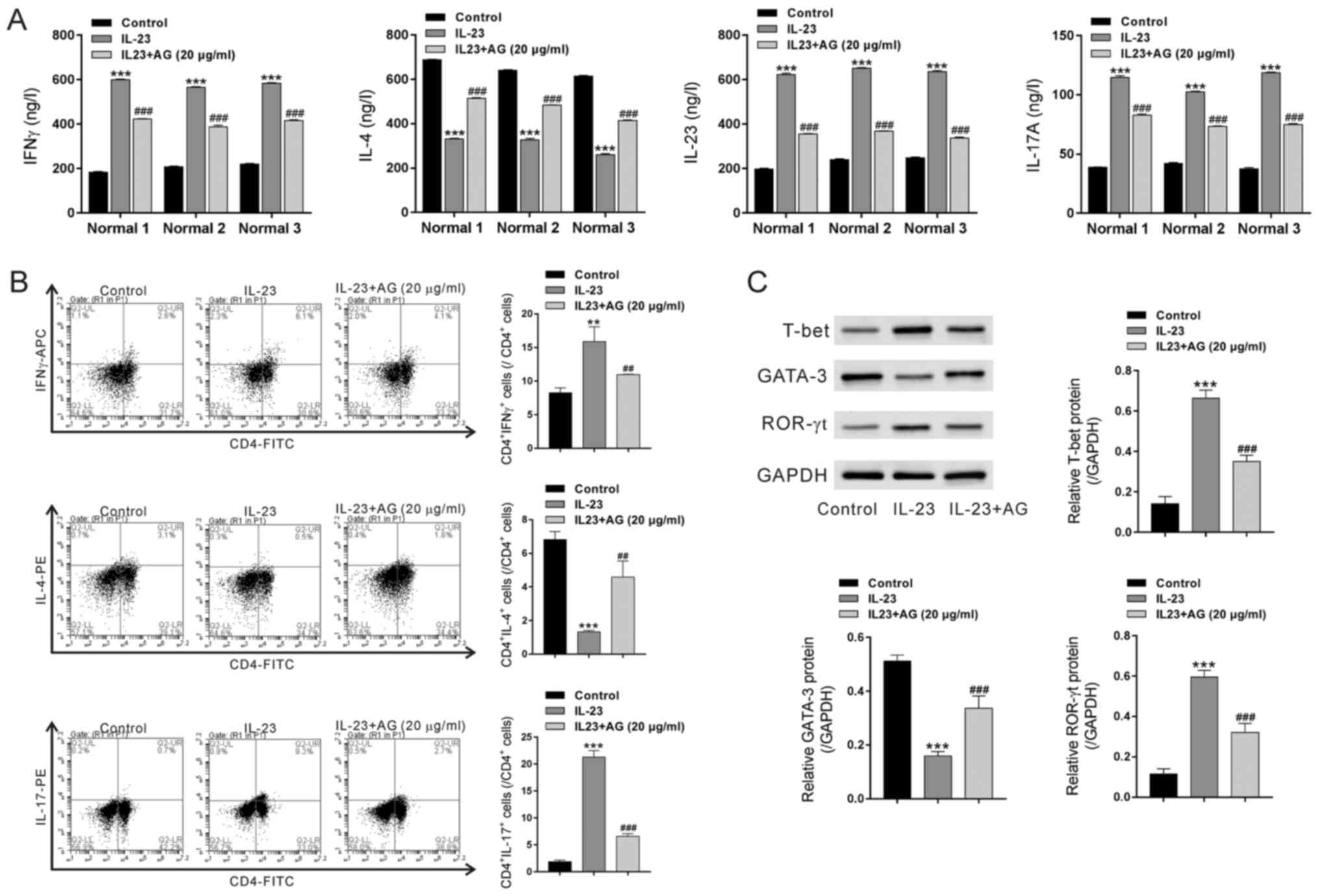Andrographolide affects Th1/Th2/Th17 responses of peripheral blood mononuclear cells from ulcerative colitis patients
- Authors:
- Published online on: May 8, 2018 https://doi.org/10.3892/mmr.2018.8992
- Pages: 622-626
Abstract
Introduction
Ulcerative colitis (UC) is a chronic, idiopathic, inflammatory bowel disease (IBD) of the colon (1,2). The primary symptoms of UC are abdominal pain and bloody diarrhea (3). The direct causes of UC are unknown, but immune system dysfunction has been implicated in the pathogenesis of UC (4). T cell responses have been intensively explored in UC. Upon activation, naive CD4+T cells differentiate into T helper 1 (Th1), Th2 and Th17 cells. The mucosal levels of interferon γ (IFNγ, a Th1 cell produced cytokine) was increased in patients with UC compared with those in normal control (5). Interleukin-4 (IL-4, a Th2 cell produced cytokine) was more frequently detected in UC than in inflammatory controls (6). By using an oxazolone colitis model, Fuss et al (7), demonstrated that UC has an increased Th2-oriented immune response. IL-17 (a Th17 cell produced cytokine) mRNA was increased in biopsy specimens from UC (8,9). IL-23, the key cytokine that promotes Th17 cells to produce IL17 (10), differentially regulates the Th1/Th17 balance in UC (11).
Approximately 50% of patients with UC can be treated with a number of medications, including 5-aminosalicylic acid (ASA) drugs, such as sulfasalazine and mesalamine (2,3,12). Patients who fail to respond to 5-ASA drugs are treated with steroids (13), azathioprine (14) and infliximab (15), which may have serious toxicity (16). Additional medical therapies for patients failing 5-ASA drugs are needed. Andrographis paniculata (AP), an important herbal medicine, has been used to treat inflammatory and infectious diseases (17–19). Andrographolide is the main active component of AP. AP extracts and andrographolide possess immunostimulatory (20,21), anti-cancer (20,22), antiviral (23) and antibacterial activities (24). AP extract (HMPL-004) showed similar efficacy to mesalamine for UC (25,26). Andrographolide sulfonate, a derivative of andrographolide, could inhibit Th1/Th17 responses and improve experimental colitis (27). However, whether andrographolide affects the T cell responses of UC patients has not been explored.
In the present study, peripheral blood mononuclear cells (PBMCs) isolated from UC patients were treated with various concentrations of andrographolide. Then, the effects of andrographolide on Th cell differentiation were investigated. Further experiments with PBMCs from healthy donors confirmed these findings.
Materials and methods
Isolation, culture and treatment of PBMCs
The present study received ethical approval from the Ethics Committee of Zhejiang Hospital. Blood samples were collected from 3 UC patients and 3 age-match healthy donors after written informed consent was obtained from all participants. Clinicopathological data of UC patients are listed in Table I. PBMCs were freshly isolated from blood samples by gradient centrifugation with lymphocyte cell separation media (Cedarlane Laboratories, Ontario, Canada) and grown in RPMI-1640 (HyClone; GE Healthcare Life Sciences, Logan, UT, USA) containing 10% fetal bovine serum (FBS; Invitrogen; Thermo Fisher Scientific, Inc., Waltham, MA, USA) and penicillin/streptomycin. The PBMCs were maintained in a 37°C incubator with 5% CO2.
PBMCs from UC patients were randomly treated with dimethyl sulfoxide (DMSO; Sigma-Aldrich; Merck KGaA, Darmstadt, Germany) and 10, 20 or 30 µg/ml of andrographolide (AG; Sigma-Aldrich; Merck KGaA). PBMCs from healthy donors were randomly divided into three groups: Control group, treated with DMSO; IL-23 group, treated with 50 ng/ml IL-23 (Sigma-Aldrich; Merck KGaA); and IL-23+AG group, treated with 20 µg/ml andrographolide for 2 h and then treated with 50 ng/ml IL-23. After 48 h of culture, the culture media were collected for enzyme-linked immunosorbent assay (ELISA), and PBMCs were harvested for flow cytometry and Western blot analysis.
ELISA assay
The culture media were collected and the concentrations of IFNγ, IL-4, IL-23 and IL-17A were measured by using commercial ELISA kits (Bio-swap, Shanghai, China) according to the manufacturer's instructions. Optic densities were measured at 450 nm, and the concentrations of cytokines were calculated according to a standard curve.
Cytokine staining and flow cytometry
The treated PBMCs were centrifuged at 1,000 rpm for 10 min. The pellet was resuspended in cultured media supplemented with PMA (100 ng/ml; Sigma-Aldrich; Merck KGaA)/ionomycin (1 µg/ml; Sigma-Aldrich; Merck KGaA) and monensin (1 µg/ml; Shanghai Aladdin Bio-Chem Technology Co., Shanghai, China) and plated onto 24-well plates (0.5×105 cells/well). After incubation at 37°C for 4 h, the PBMCs were collected, resuspended in phosphate-buffered saline (PBS) and labeled with anti-CD4-FITC (BioLegend, Inc., San Diego, CA, USA) for 1 h at 4°C. Subsequently, the cells were fixed with 2% formaldehyde and permeabilized with 0.1% Triton X-100 in PBS. Intracellular cytokine staining was then performed with anti-IFNγ-APC, anti-IL-4-PE or anti-IL-17A-PE (BioLegend, Inc.) for 1 h. The cells were detected by using flow cytometry (BD Biosciences, Franklin Lakes, NJ, USA). The proportions of CD4+IFNγ+ cells, CD4+IL-4+ cells and CD4+IL-17A+ cells (right upper quadrant) in CD4+ cells (right upper and lower quadrant) were calculated.
Western blot analysis
PBMCs was lysed in RIPA buffer and then centrifuged at 12,000 rpm for 20 min. The supernatant was collected, and the protein concentrations were quantified by using a BCA method. An equal amount of protein (30 µg) from each sample was loaded onto 10% sodium dodecyl sulfate (SDS)-polyacrylamide gels and transferred onto a nitrocellulose blotting membrane (EMD Millipore, Billerica, MA, USA). Following incubation with 5% skim milk at 4°C for 1 h, the membranes were incubated with anti-T-bet (cat. no. Ab91109, 1:500; Abcam, Cambridge, MA, USA), anti-GATA-3 (cat. no. Ab106625, 1:1,000; Abcam), anti-ROR-γt (cat.no. Ab78007, 1:1,500; Abcam) and anti-GAPDH (cat. no. 5174, 1:2,000; Cell Signaling Technology, Danvers, MA, USA) antibodies at 4°C overnight. Then, the membrane was washed three times with TBST buffer and incubated with horseradish peroxidase conjugated secondary antibody (Beyotime Institute of Biotechnology, Shanghai, China) for 1 h. Immunoreactive bands were detected using an ECL detection kit (Bio-Rad Laboratories, Inc., Hercules, CA, USA) and semi-quantified by ImageJ software (http://rsb.info.nih.gov/ij/, National Institutes of Health, Bethesda, MD, USA).
Statistical analysis
Data are expressed as the means ± standard deviation (SD). Statistical analysis was performed with GraphPad Prism software (v6.0, San Diego, CA, USA). One-way analysis of variance with a Tukey's post hoc test was performed. P<0.05 was considered to indicate a statistically significant difference.
Results
Effects of andrographolide on the release of IFNγ, IL-4, IL-23 and IL-17A in PBMCs from UC patients
To examine the effect of andrographolide on the production of Th cell-specific cytokines, PBMCs were isolated from three UC patients and treated with 10, 20 or 30 µg/ml of andrographolide. The concentrations of cytokines in the culture media were determined by an ELISA assay. After 48 h of treatment, andrographolide decreased IFNγ, IL-23 and IL-17A but increased IL-4 in a dose-dependent manner (Fig. 1).
Effects of andrographolide on Th cell subset in PBMCs from UC patients
To analyze the effect of andrographolide on subtypes of Th cell populations, PBMCs treated with andrographolide were stained with IFNγ, IL-4 and IL-17A in CD4+ T cells, which are the respective signature cytokines of Th1, Th2 and Th17 cells. Andrographolide treatment resulted in a decreased percentage of Th1 and Th17 cells and an increased proportion of Th2 cells (Fig. 2).
Effects of andrographolide on the protein levels of T-bet, GATA3 and ROR-γt in PBMCs from UC patients
The protein expression levels of the transcription factors, T-bet, GATA-3 and ROR-γt, of the T lymphocytes were measured, and the results showed that T-bet and ROR-γt expression was decreased (n = 3); however, GATA-3 expression was increased after andrographolide treatment (n=3, Fig. 3).
Effects of andrographolide on IL-23-treated PBMCs from healthy donors
We next explored the effects of andrographolide pretreatment on IL-23-treated PBMCs from healthy donors. As shown in Fig. 4, IL-23 treatment significantly increased the concentrations of IFNγ, IL-23 and IL-17A but decreased the concentrations of IL-4. IL-23 exposure caused a notable increase in the percentages of IFNγ+CD4+ cells and IL-17+CD4+ but a decrease in the percentages of IL-4+CD4+ cells. Additionally, IL-23 treatment significantly increased the protein levels of T-bet and ROR-γt but reduced GATA-3 expression. Pretreatment with andrographolide significantly rescued the effects of IL-23 on PBMCs.
Discussion
Th1, Th2 and Th17 immune responses have been associated with the pathology of UC (5–7). AP extract (HMPL-004) was efficient for UC treatment (25,26). In the present study, we examined whether andrographolide, the main active component of AP, affected T cell responses of UC patients.
First, PBMCs isolated from UC patients were treated with various concentrations of andrographolide. The concentrations of IFNγ (a Th1 cell produced cytokine), IL-23 and IL-17A (Th17 cell produced cytokine) in the culture medium, the percentages of Th1 and Th17 cells, and the protein levels of T-bet (a transcription factor directing Th1 lineage commitment (28)) and ROR-γt (Th17 lineage-specific transcription factor (29)) were significantly decreased by andrographolide treatment. These data suggested that andrographolide could inhibit Th1/Th17 response. These findings were consistent with those of a previous study of andrographolide sulfonate in mice (27). In contrast, the concentrations of IL-4 (a Th2 cell produced cytokine) in the culture medium, the percentages of Th2 cells, and the protein levels of GATA-3 (Th2 lineage-specific transcription factor (30)) were significantly increased by andrographolide treatment. The present study demonstrated that andrographolide could inhibit Th1/Th17 responses and enhance the Th2 response of PBMCs from UC patients.
Recently, increasing evidence has established correlative links between the association of IL-23/IL-17 axis and the frequency of several human autoimmune or immune-mediated inflammatory diseases, such as Crohn disease, psoriasis and spondyloarthritis (31–33). Then, we treated PBMCs from healthy donors with IL-23 to induce a Th17 response. IL-23 treatment significantly increased Th1/Th17 responses but decreased the Th2 response, as indicated by the concentrations of specific cytokines, the percentages of Th cell subsets, and the levels of specific transcription factors. More importantly, andrographolide pretreatment rescued the effects of IL-23. These data suggested that andrographolide might effectively treat other IL-23-mediated diseases. Further studies are needed to investigate the therapeutic effects of andrographolide on such diseases.
In conclusion, the present study explored the effects of andrographolide on the Th1/Th2/Th17 responses of PBMCs from UC patients and IL-23-treated-PBMCs from healthy donors. These results suggest that andrographolide can be an effective candidate for the treatment of IL-23-mediated diseases.
Acknowledgments
Not applicable.
Funding
This study was financially supported through grants from the Natural Science Foundation of Zhejiang Province (LQ15H030005), Medical and Health Science and Technology Plan of Zhejiang Province (2015KYA011) and the Natural Science Foundation of Zhejiang Province (Y17H030031).
Availability of data and materials
All data generated or analyzed during this study are included in this published article.
Authors' contributions
QZ and PZ conceived and designed the study. QZ, JZ, XC, YF, WW, FZ and QH performed the experiments. QZ and PZ wrote the manuscript. All authors read and approved the final manuscript.
Ethics approval and consent to participate
The present study received ethical approval from the Ethics Committee of Zhejiang Hospital and written informed consent was obtained from all participants.
Consent for publication
Written informed consent was obtained from all participants for the publication of their data and any accompanying images.
Competing interests
The authors declare that they have no competing interests.
References
|
Baumgart DC and Sandborn WJ: Inflammatory bowel disease: Clinical aspects and established and evolving therapies. Lancet. 369:1641–1657. 2007. View Article : Google Scholar : PubMed/NCBI | |
|
Baumgart DC and Carding SR: Inflammatory bowel disease: Cause and immunobiology. Lancet. 369:1627–1640. 2007. View Article : Google Scholar : PubMed/NCBI | |
|
Kornbluth A and Sachar DB: Practice Parameters Committee of the American College of Gastroenterology: Ulcerative colitis practice guidelines in adults: American College Of Gastroenterology, Practice Parameters Committee. Am J Gastroenterol. 105:501–524. 2010. View Article : Google Scholar : PubMed/NCBI | |
|
Akiho H, Yokoyama A, Abe S, Nakazono Y, Murakami M, Otsuka Y, Fukawa K, Esaki M, Niina Y and Ogino H: Promising biological therapies for ulcerative colitis: A review of the literature. World J Gastrointest Pathophysiol. 6:219–227. 2015. View Article : Google Scholar : PubMed/NCBI | |
|
Masuda H, Iwai S, Tanaka T and Hayakawa S: Expression of IL-8, TNF-alpha and IFN-gamma m-RNA in ulcerative colitis, particularly in patients with inactive phase. J Clin Lab Immunol. 46:111–123. 1995.PubMed/NCBI | |
|
Inoue S, Matsumoto T, Iida M, Mizuno M, Kuroki F, Hoshika K and Shimizu M: Characterization of cytokine expression in the rectal mucosa of ulcerative colitis: Correlation with disease activity. Am J Gastroenterol. 94:2441–2446. 1999. View Article : Google Scholar : PubMed/NCBI | |
|
Fuss IJ, Heller F, Boirivant M, Leon F, Yoshida M, Fichtner-Feigl S, Yang Z, Exley M, Kitani A, Blumberg RS, et al: Nonclassical CD1d-restricted NK T cells that produce IL-13 characterize an atypical Th2 response in ulcerative colitis. J Clin Invest. 113:1490–1497. 2004. View Article : Google Scholar : PubMed/NCBI | |
|
Fujino S, Andoh A, Bamba S, Ogawa A, Hata K, Araki Y, Bamba T and Fujiyama Y: Increased expression of interleukin 17 in inflammatory bowel disease. Gut. 52:65–70. 2003. View Article : Google Scholar : PubMed/NCBI | |
|
Annunziato F, Cosmi L, Santarlasci V, Maggi L, Liotta F, Mazzinghi B, Parente E, Filì L, Ferri S, Frosali F, et al: Phenotypic and functional features of human Th17 cells. J Exp Med. 204:1849–1861. 2007. View Article : Google Scholar : PubMed/NCBI | |
|
Korn T, Bettelli E, Oukka M and Kuchroo VK: IL-17 and Th17 cells. Annu Rev Immunol. 27:485–517. 2009. View Article : Google Scholar : PubMed/NCBI | |
|
Kobayashi T, Okamoto S, Hisamatsu T, Kamada N, Chinen H, Saito R, Kitazume MT, Nakazawa A, Sugita A, Koganei K, et al: IL23 differentially regulates the Th1/Th17 balance in ulcerative colitis and Crohn's disease. Gut. 57:1682–1689. 2008. View Article : Google Scholar : PubMed/NCBI | |
|
Harbord M, Eliakim R, Bettenworth D, Karmiris K, Katsanos K, Kopylov U, Kucharzik T, Molnár T, Raine T, Sebastian S, et al: Third European evidence-based consensus on diagnosis and management of ulcerative colitis. Part 2: Current management. J Crohns Colitis. 11:769–784. 2017. View Article : Google Scholar : PubMed/NCBI | |
|
Truelove SC and Witts LJ: Cortisone in ulcerative colitis; final report on a therapeutic trial. Br Med J. 2:1041–1048. 1955. View Article : Google Scholar : PubMed/NCBI | |
|
Leung Y, Panaccione R, Hemmelgarn B and Jones J: Exposing the weaknesses: A systematic review of azathioprine efficacy in ulcerative colitis. Dig Dis Sci. 53:1455–1461. 2008. View Article : Google Scholar : PubMed/NCBI | |
|
Rutgeerts P, Sandborn WJ, Feagan BG, Reinisch W, Olson A, Johanns J, Travers S, Rachmilewitz D, Hanauer SB, Lichtenstein GR, et al: Infliximab for induction and maintenance therapy for ulcerative colitis. N Engl J Med. 353:2462–2476. 2005. View Article : Google Scholar : PubMed/NCBI | |
|
Lichtenstein GR, Abreu MT, Cohen R and Tremaine W: American Gastroenterological Association: American Gastroenterological Association Institute technical review on corticosteroids, immunomodulators, and infliximab in inflammatory bowel disease. Gastroenterology. 130:940–987. 2006. View Article : Google Scholar : PubMed/NCBI | |
|
Poolsup N, Suthisisang C, Prathanturarug S, Asawamekin A and Chanchareon U: Andrographis paniculata in the symptomatic treatment of uncomplicated upper respiratory tract infection: Systematic review of randomized controlled trials. J Clin Pharm Ther. 29:37–45. 2004. View Article : Google Scholar : PubMed/NCBI | |
|
Coon JT and Ernst E: Andrographis paniculata in the treatment of upper respiratory tract infections: A systematic review of safety and efficacy. Planta Med. 70:293–298. 2004. View Article : Google Scholar : PubMed/NCBI | |
|
Saxena RC, Singh R, Kumar P, Yadav SC, Negi MP, Saxena VS, Joshua AJ, Vijayabalaji V, Goudar KS, Venkateshwarlu K and Amit A: A randomized double blind placebo controlled clinical evaluation of extract of Andrographis paniculata (KalmCold) in patients with uncomplicated upper respiratory tract infection. Phytomedicine. 17:178–185. 2010. View Article : Google Scholar : PubMed/NCBI | |
|
Kumar RA, Sridevi K, Kumar NV, Nanduri S and Rajagopal S: Anticancer and immunostimulatory compounds from Andrographis paniculata. J Ethnopharmacol. 92:291–295. 2004. View Article : Google Scholar : PubMed/NCBI | |
|
Puri A, Saxena R, Saxena RP, Saxena KC, Srivastava V and Tandon JS: Immunostimulant agents from Andrographis paniculata. J Nat Prod. 56:995–999. 1993. View Article : Google Scholar : PubMed/NCBI | |
|
Rajagopal S, Kumar RA, Deevi DS, Satyanarayana C and Rajagopalan R: Andrographolide, a potential cancer therapeutic agent isolated from Andrographis paniculata. J Exp Ther Oncol. 3:147–158. 2003. View Article : Google Scholar : PubMed/NCBI | |
|
Wiart C, Kumar K, Yusof MY, Hamimah H, Fauzi ZM and Sulaiman M: Antiviral properties of ent-labdene diterpenes of Andrographis paniculata nees, inhibitors of herpes simplex virus type 1. Phytother Res. 19:1069–1070. 2005. View Article : Google Scholar : PubMed/NCBI | |
|
Singha PK, Roy S and Dey S: Antimicrobial activity of Andrographis paniculata. Fitoterapia. 74:692–694. 2003. View Article : Google Scholar : PubMed/NCBI | |
|
Sandborn WJ, Targan SR, Byers VS, Rutty DA, Mu H, Zhang X and Tang T: Andrographis paniculata extract (HMPL-004) for active ulcerative colitis. Am J Gastroenterol. 108:90–98. 2013. View Article : Google Scholar : PubMed/NCBI | |
|
Tang T, Targan SR, Li ZS, Xu C, Byers VS and Sandborn WJ: Randomised clinical trial: Herbal extract HMPL-004 in active ulcerative colitis-a double-blind comparison with sustained release mesalazine. Aliment Pharmacol Ther. 33:194–202. 2011. View Article : Google Scholar : PubMed/NCBI | |
|
Liu W, Guo W, Guo L, Gu Y, Cai P, Xie N, Yang X, Shu Y, Wu X, Sun Y and Xu Q: Andrographolide sulfonate ameliorates experimental colitis in mice by inhibiting Th1/Th17 response. Int Immunopharmacol. 20:337–345. 2014. View Article : Google Scholar : PubMed/NCBI | |
|
Szabo SJ, Kim ST, Costa GL, Zhang X, Fathman CG and Glimcher LH: A novel transcription factor, T-bet, directs Th1 lineage commitment. Cell. 100:655–669. 2000. View Article : Google Scholar : PubMed/NCBI | |
|
Ayyoub M, Deknuydt F, Raimbaud I, Dousset C, Leveque L, Bioley G and Valmori D: Human memory FOXP3+ Tregs secrete IL-17 ex vivo and constitutively express the TH17 lineage-specific transcription factor RORγt. PNAS. 106:8635–8640. 2009. View Article : Google Scholar : PubMed/NCBI | |
|
Zheng W and Flavell RA: The transcription factor GATA-3 is necessary and sufficient for Th2 cytokine gene expression in CD4 T cells. Cell. 89:587–596. 1997. View Article : Google Scholar : PubMed/NCBI | |
|
Neurath MF: IL-23: A master regulator in Crohn disease. Nat Med. 13:26–28. 2007. View Article : Google Scholar : PubMed/NCBI | |
|
Iwakura Y and Ishigame H: The IL-23/IL-17 axis in inflammation. J Clin Invest. 116:1218–1222. 2006. View Article : Google Scholar : PubMed/NCBI | |
|
Di Cesare A, Di Meglio P and Nestle FO: The IL-23/Th17 axis in the immunopathogenesis of psoriasis. J Invest Dermatol. 129:1339–1350. 2009. View Article : Google Scholar : PubMed/NCBI |













